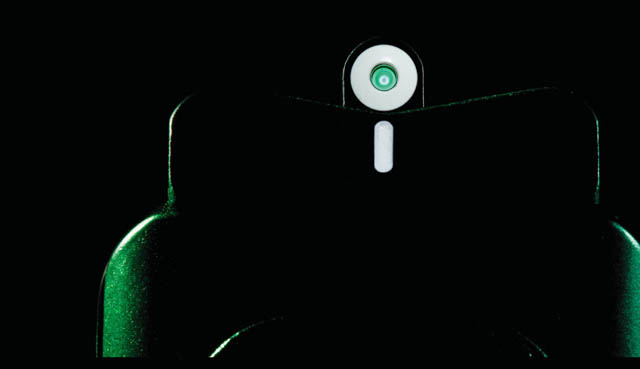
Professional hunters in Africa often kill game that could kill them if they fail in their efforts to quickly stop these dangerous beasts. Their guns, called express rifles because of the ammunition they fire and the sights they wear, are often brought to bear from awkward and up-close positions at times of great stress against creatures that threaten to do these men serious harm.
About 20 years ago, Ashley Emerson saw parallels in how professional hunters stopped charging animals and how other people used handguns to deal with deadly threats of the two-legged variety. Emerson had been involved in manufacturing handgun sights at the Miniature Machine Company, and he realized that getting off effective shots within the shortest possible time frame was important in both dangerous-game hunting and self-defense.
Sights on express rifles generally utilize a large white or brightly colored front bead, and a wide V-notch rear blade. This combination allows the hunter to rapidly relate one to the other so the gun can be quickly driven to a vital spot on the target. Emerson thought he could apply this concept to pistols and revolvers.

Right away, however, he recognized some things had to change. Differences in eye-to-sight distances and how the sights appeared at arm's length required changes in the rear assembly.
The front bead underwent similar evaluations, and it changed as well. Moving away from what often appeared to be a ball balanced on top of a post, Emerson developed a front sight that, when viewed from the rear, looked like a large dot floating in space. It was to become known as the Big Dot front sight, and it's not merely just another bead.
Emerson and his partner, the late Ed Pastusek, launched A&E Manufacturing based on this concept. More refinements followed, as did a number of patents and a series of companies—Ashley Outdoors, AO Sight Systems, Express Sight Systems and currently, XS Sight Systems. Over time, an even larger dot was introduced and took on the Big Dot name. The original size is now called the Standard Dot. The company added tritium inserts to both its front and rear sights, calling them the 24/7 line because of their round-the-clock visibility. Today, XS Sight Systems even offers specialized front sights for handguns where the company's V-notch rear cannot be installed. Although Emerson is no longer with the company, Pastusek's son Jon serves as president and general manager. He and Dave Biggers, vice president of sales and marketing, continue to expand on Emerson's original idea.

Do XS Express Sights work? I think so, and I have been telling people about them ever since they became commercially available. I've taught police instructors for a long time, and I emphasize focusing on and effectively using the front sight.
People who are both practiced and have faced danger in the past will watch the front sight when confronted with a deadly force threat and will take it, and the gun, to that threat. Less experienced people will not focus on the front sight, but will look at whatever is trying to harm them instead. They are merely doing what they've been doing their entire lives. Reacting properly is often thought to result from practice and experience, and it's one of the reasons we train.
I believe the Express Big Dot concept fully supports either response to a threat. People who are practiced enough to focus on the front sight can easily pick up the larger-than-average dot, reference it to the V-notch rear (rather than align it in the traditional sense) and then drive the gun to the threat. People who, under the threat of death, zone in on the danger can bring the gun up and take the shot as soon as the easily recognizableBig Dot breaks their line of sight.
I also feel the Express Big Dot system makes a handgun easier to drive to a threat than a conventional sight arrangement. If the threat moves while still requiring engagement or if a second threat appears, the Big Dot only has to be related to the stripe on the V-notch rear, rather than aligned in a traditional square notch. The Express Big Dot alignment method has become known as "dotting the I" for the simplicity of the correct relationship between the front and rear sights. Traditional sights are normally more difficult and time-consuming to align and to keep aligned, particularly if the target is moving.
Handgun manufacturers like Ruger and Smith & Wesson offer the Big Dot as standard equipment on some models. In fact, this year you will also see guns from Beretta, Colt, Marlin, Mossberg, North American Arms and Henry Repeating Arms come from the factory wearing various types of XS sights. The company has also grown its line to offer aftermarket sights for guns like the Kahr P380, SIG Sauer P238 and Ruger SR9, as well as more complicated switch-outs like traditional Smith & Wesson J-frames with 1 7⁄8-inch barrels topped with integral front sights. Soon, there should also be Big Dot sights for both of Smith & Wesson's Bodyguards.

But let's not forget, the thinking behind XS Sight Systems' products originated with long guns. Fittingly, the company has gone full circle to include shotgun, rifle and carbine sights. Among the options are24/7 Express Sight sets for Remington Model 870 shotguns. Ghost-Ring configurations that offer an aperture rear in combination with either a Big Dot or a vertically striped front post are also available for several models, including Mossberg and Remington.
In addition, XS has come up with a rugged Ghost-Ring rear/stripe front post combo for a wide variety of bolt-action and lever-action rifles. Of course, AR-style rifles have not been neglected. The company's Same Plane dual-aperture rear sight for AR-type rifles is available with a White or Tritium Stripe front post, or a Standard or Big Dot. And let's not forget the AK: XS offers a combo with an Express Sight rear and a Big Dot front for this platform, as well as a replacement Stripe front post.
Biggers told me XS tries hard to take a broad look at things, which is why the company offers Express Sights for some guns, but provides Ghost-Ring sights for others. It's also why XS makes Express Sights for rifles like the AK, where a Ghost-Ring application isn't possible and the forward-mounted rear sight must remain. Yet another example of the company's dedication to providing the end-user with options is its partnership with Combat Shooting and Tactics in offering the CSAT rear sight for AR-style rifles. Taking the dual-aperture concept to the limit, the CSAT combines a Ghost-Ring with a unique combination blade that stacks a handgun-like rear notch above a conventional aperture.

As with handguns, Express Sights are ideal on long guns for fast and relatively close engagements where the gun must be quickly driven to the threat. And while these sights work more effectively at longer ranges than many people assume, what about the need to take shots at even greater distances? This is where the Ghost-Ring concept really shines.
Rather than requiring the user to pick up a traditional rear sight halfway down the barrel, orient it with a front sight that's even farther away and ultimately place them both on a distant target, the Ghost-Ring rear sight is located near the eye and forces the operator's vision through it. When the user focuses on the front sight, the rear aperture becomes a fuzzy, ghost-like image that gives the sight its name and causes the brain to help center the front sight within the ring. This allows the shooter to, once again, drive the gun to the threat without all of the difficulty normally encountered in trying to keep conventional sights aligned and on target while under stress.
I have heard claims that XS sight designs are "accurate enough" for up-close engagements, but are lacking in regard to other applications. Not only do people draw from their own experiences, but they also point to the inclusion of the Ghost-Ring sights within the long-gun line as evidence of the need for something more when it comes to greater distances.
Let's address that second issue first. As most commonly encountered battle rifles today (except for the AK) employ a rear sight located close to the eye to begin with, it only makes sense to upgrade what's already there to the more beneficial Ghost-Ring concept. If we look at how these rifles might be employed at 200 and 300 yards, we can see that any blade-type rear sight located near the rear of the receiver would be at a disadvantage. And because of its smaller opening, a peep-type aperture can often be slower to employ than required in a fighting situation. The Ghost-Ring design addresses these issues while lending itself to applications for which express sights were neither designed nor intended.
In the case of handguns, there are several things to consider. Fighting is not target shooting, and in civilian engagements, the gun is typically used at relatively close distances. Even in law enforcement circles, most officers (there are exceptions) aren't taught to use a handgun at distances much beyond 25 or 35 yards.
Having shot Express Big Dot sights on handguns at those distances and beyond, they are more than adequate. They are certainly not a detriment to performance at such ranges if the shooter is willing to practice.
Many of those whom I have heard complain about accuracy or speed seem to be applying years of square-peg-in-a-square-hole sight alignment to something that neither looks nor works like that. I believe if people are willing to practice and accept the image, as well as the idea of referencing rather than forcibly aligning the dot and the V, they will find the Express Big Dot system is very accurate. More importantly, it is capable of allowing any responder to an armed attack to do far more in less time—Emerson's original goal.




































